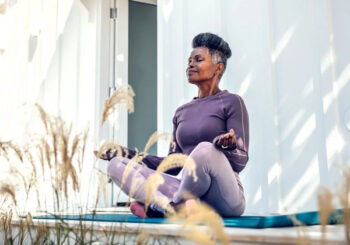By John Patterson
Staff Writer for Wake Up World
In our quest to decipher the intricate relationship between mind and body, ancient practices are finding validation in modern scientific exploration. The realm of mindfulness meditation has long intrigued seekers of relief, and now, with the aid of cutting-edge neuroscience, researchers from the University of California San Diego School of Medicine have delved into the science behind mindfulness’s impact on pain perception and brain activity.
Published on July 7, 2022, in the journal PAIN, this study sheds light on how mindfulness meditation might transform the experience of pain and holds the promise of a novel, non-pharmacological avenue for pain management.
Mindfulness and Pain: A Neuroscientific Odyssey
The intersection of mindfulness and pain has ignited curiosity for centuries, and now, thanks to recent advancements, neuroscientists are poised to unveil the mysteries of this ancient practice’s effect on our perception of pain. The study from the University of California San Diego School of Medicine offers a fascinating glimpse into this interplay, revealing a mechanism through which mindfulness meditation disrupts the connection between brain regions responsible for pain sensation and those associated with self-awareness.
The Inner Mechanism Unveiled
Senior author of the study, Fadel Zeidan, PhD, Associate Professor of Anesthesiology at UC San Diego School of Medicine, illuminates the crux of the phenomenon, stating, “One of the central tenets of mindfulness is the principle that you are not your experiences.” By cultivating the ability to observe thoughts and sensations without attaching one’s ego or sense of self to them, individuals may untangle themselves from the web of pain and suffering. The research hones in on this pivotal realization, observed through the lens of acute pain experiences.
Unraveling the Study’s Threads
The study enlisted 40 participants, their brains subjected to scans while a series of painful heat stimuli were applied to their legs. After undergoing these experiences, participants gauged their average pain levels. Subsequently, the participants were divided into two groups: one engaged in four separate 20-minute mindfulness training sessions, focusing on breath and releasing self-referential thoughts, while the other group listened to an audio book.
On the study’s culmination, both groups underwent another round of brain activity measurements. A crucial distinction emerged: participants who actively engaged in mindfulness meditation during the painful heat reported a remarkable 32 percent reduction in pain intensity and a concurrent 33 percent reduction in pain unpleasantness.
The Brain’s Symphony of Pain Relief
Digging into the neurological underpinnings of this transformative process, researchers uncovered a mesmerizing connection. The synchronization between the thalamus (a relay for sensory information) and components of the default mode network (a cluster of brain areas associated with introspection) was diminished during mindfulness-induced pain relief.
This decoupling of brain regions, including the precuneus and ventromedial prefrontal cortex, correlated with heightened pain relief. This bears the promise of understanding a novel non-opioid-based pain mechanism, a beacon of hope in an era gripped by the opioid crisis.
Embracing a Mindful Tomorrow
Mindfulness meditation, a free practice accessible anywhere, presents itself as a beacon of hope for those seeking pain relief without resorting to pharmaceutical interventions. Zeidan envisions a future where mindfulness is seamlessly integrated into standard outpatient procedures, offering a new dawn for those ensnared by chronic pain. As science peels back the layers of the mind-body connection, the age-old wisdom of mindfulness stands poised to revolutionize the landscape of pain management, ushering in a paradigm shift that prioritizes holistic well-being.
Conclusion
With the symphony of the mind and the dance of pain, we uncover the potential of mindfulness meditation to transform our perception of suffering. As science and ancient wisdom converge, we step onto a path that bridges the realms of neurobiology and spirituality, offering respite for those grappling with pain’s relentless grip. With each mindful breath, a new chapter of pain management unfolds, inviting us to embrace the power of the present moment in our journey towards healing.
Reference:
- Gabriel Riegner, Grace Posey, Valeria Oliva, Youngkyoo Jung, William Mobley, Fadel Zeidan. Disentangling self from pain: mindfulness meditation-induced pain relief is driven by thalamic-default mode network decoupling. Pain, 2022; Publish Ahead of Print DOI: 10.1097/j.pain.0000000000002731
About the author:
John Patterson is an avid writer and researcher who delves into the latest scientific research. With an insatiable curiosity, he translates complex concepts into accessible narratives, allowing readers to embark on a journey of discovery. Through his work, John bridges the gap between experts and the public, igniting curiosity and inspiring meaningful conversations about scientific breakthroughs.

If you've ever found value in our articles, we'd greatly appreciate your support by purchasing Mindful Meditation Techniques for Kids - A Practical Guide for Adults to Empower Kids with the Gift of Inner Peace and Resilience for Life.
In the spirit of mindfulness, we encourage you to choose the paperback version. Delve into its pages away from screen glare and notifications, allowing yourself to fully immerse in the transformative practices within. The physical book enriches the learning process and serves as a tangible commitment to mindfulness, easily shared among family and friends.
Over the past few years, Wake Up World has faced significant online censorship, impacting our financial ability to stay online. Instead of soliciting donations, we're exploring win-win solutions with our readers to remain financially viable. Moving into book publishing, we hope to secure ongoing funds to continue our mission. With over 8,500 articles published in the past 13 years, we are committed to keeping our content free and accessible to everyone, without resorting to a paywall.








